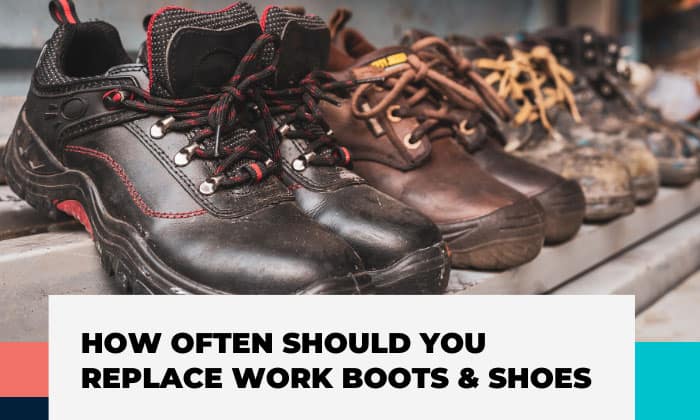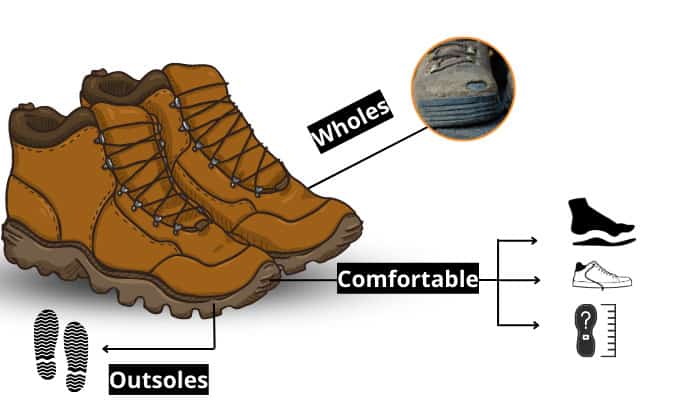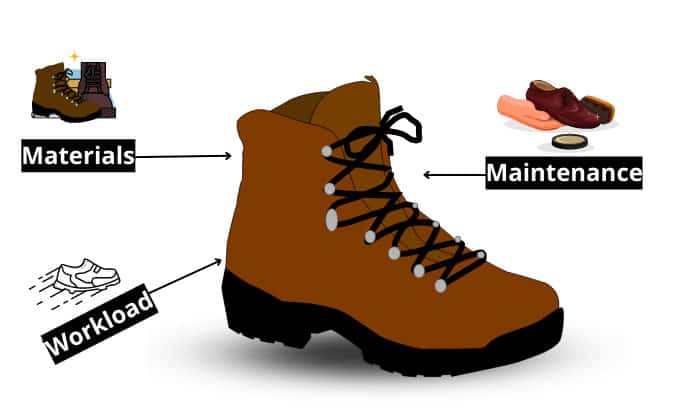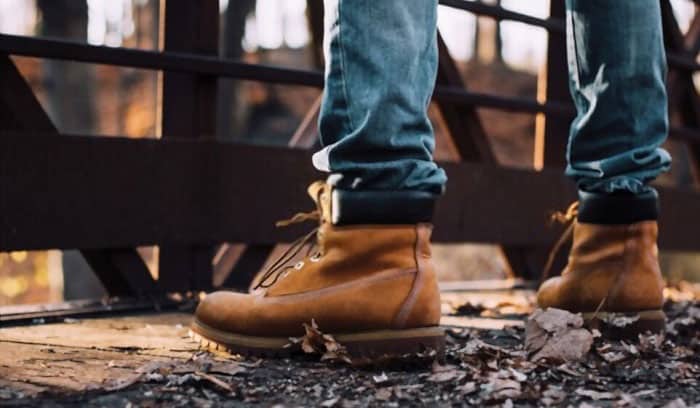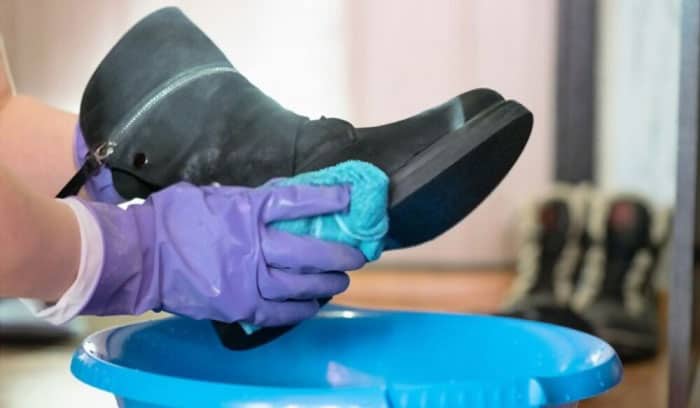The work footwear will protect you from injury risk. These shoes must be in good condition. The old boots increase the chance of getting injured. That’s why you have to understand how often should you replace work boots & shoes.
The general rule is you should replace work shoes every 6 – 12 months. You can wear your boots for up to 24 months if you care for them and their durable materials.
If you work in harsh environments, you need to pay extra attention to your shoes’ conditions.
Table of Contents
How Often Should You Replace Work Boots and Shoes
“How long do work boots last” depends on many factors.
The rule of thumb is you need to buy new shoes after every 6-12 months. But, this is not true for all work boots due to the variations in boot construction and working conditions.
Do you work in harsh environments and move constantly? The better idea is to substitute your work boots after 3-6 months.
The premium-quality footwear can last 24 months or even 36 months under average conditions. But, you can replace your shoes sooner when you realize uncommon signs.
Materials and kind of work shoes are the core elements affecting boots’ longevity. Among leather, suede, and cowboy shoes, cowboy boots have the longest lasting work boots – up to a decade or at least 5 years.
The leather boots can live well for up to 6 months. Meanwhile, you can wear suede shoes for 4-5 months in the engineering field. Cowboy and leather shoes are well-built for the construction industry.
These timelines aren’t totally correct. You have to observe to know “should safety boots be replaced.”
Check Your Work Boots and Shoes
1. Outsoles
The outsoles are the surface exposed to the ground, thus being worn down fastest as you move around. Over time, these outsoles suffer a lot of pressure and friction. You can gradually notice little holes, lint-like shapes, and cracks when its condition worsens.
If you continue wearing these boots, you will have worn out work boots. The thread is designed to offer you a better grip. Hard-to-see thread means less secure while stepping on wet or slick roads. Hence, the denser and clearer threads are safer for you.
The outsoles also act as protection and insulation between your feet and the ground. No one wants to get injured in this case, so it is the right time for replacement work boot soles.
Several tips for you to check the shoes’ status. You can check the rim of the shoes to find cracks. Its material is rubber, so it is quite easy to watch. Moreover, you can choose resolable designs to save your budget.
You can check your outsoles every other week by flipping over the shoes to replace them on time.
2. Wholes
If you find holes in your work boots, you need to buy new shoes immediately. Small holes can lead to water penetration which is an enemy of leather.
As moisture evaporates completely, you can realize some bleached spots. A more complicated issue is the brittle upper. Once the upper is damaged, the cap’s position can be changed. Hence, it’s dangerous when you wear worn out steel toe boots.
The holes make socks damp, lowering your body temperature if you wear them for a while. Also, the moisture and seal environment is an ideal environment for fungus bacteria.
For wearers working in industries: electricity, chemicals, construction, and more. The leaked shoes make your feet contact dangerous elements. The short-term amendment is to stitch the holes. But, it is advisable to replace work shoes.
3. Comfortable
Wearing work boots is for your safety and feelings. As you don’t find it comfortable, purchase new ones. Footbeds, midsoles, and ergonomic designs are 3 factors deciding your comfort.
01 Footbeds/InsolesCushioned footbeds should provide you with enough support. So, your ankles won’t be hurt after you wear boots for hours. If the insoles are pressed and don’t bounce back anymore, you will feel pain while walking.
Moreover, pressed insoles are less ventilated. Your feet will sweat more causing fungus and bad odors.
02 MidsolesMidsoles are the middle layer between insoles and outsoles. They are made from different materials: EVA foam, leather, cork, rubber, and others. They play as a cushion to absorb shock and protect your feet.
They usually suffer a lot of pressure while stepping. In case shoes don’t absorb shock, they must be damaged. For cheap midsoles, you need to replace work boots after 6-12 months.
03 DesignThe last factor impacting your comfort is ergonomic design. Work footwear should mold your feet and promote safety. Manufacturers can add several accessories: medial attachment and torsion.
Choosing the correct shoe size is a significant element. Too big or too small boots make you unpleasant and hard to wear. The worst case is you feel strained, affecting your productivity.
Waterproof and Insulated
For dry and warm feet, waterproofing and insulation are 2 key factors you shouldn’t miss. Waterproof work shoes add an impermeable membrane to the upper and lining.
Thanks to wise woven fabrics, your feet will be breathable yet still water-repellent. Insulated safety shoes are necessary for those who usually work in winter. There is a Thinsulate layer in these boots.
It comes in different weights (200-1000 grams) to serve various low temperatures. This lining will stop cold air from exposing your feet. So you will always feel warm.
How Many Miles Do Work Boots Last?
How far you have gone in the work boots will determine when you need to buy new shoes. Under normal conditions, you can use work boots for 6 months, equaling 300-500 miles. Moreover, maintaining and cleaning work shoes will also impact their shelf life.
Do You Need to Change Your Work Shoes?
The sturdy answer is yes. The soles will separate. Your feet won’t be safe. You usually work with water or dangerous chemicals. But, the shoes aren’t waterproof and insulated anymore. You are putting yourself in risky situations.
The shoes’ cracks with blisters can pick your feet and make you uncomfortable. Your work shoes have experienced a lot of pressure, making their appearance dull and old. You will look old-fashioned and disheveled if you don’t buy new shoes.
Factors Affecting Work Boots Lifespan
1. Materials
Work boots are usually made from leather, synthetic, suede, and rubber. Except for rubber, they are good materials for the upper.
Rubber soles are the most durable. Suede and synthetic can ensure good use, but leather is resistant to water, chemicals, and oil. Make sure to choose work boots with premium quality.
2. Maintenance
Work boots are designed for labor tasks. Hence, the build-up debris can ruin the shoes. You should clean them more often and keep them away from sunlight and moisture.
Using boots condition also helps to extend their lifespan. Reddit advises you to condition boots whenever you find dry spots.
3. Workload
Once you wear work shoes under severe conditions and do tough jobs, they will wear out soon. If you wear work boots in non-tough jobs like the office, they still wear out over time.
Signs to Know When You Need New Boots
- You can be slipping or sliding when the outsoles are already worn out.
- The uppers cannot cover your toes anymore. They look like they talk with you with open-mouth uppers.
- There are holes in the work boots.
- The insoles and midsoles don’t bounce back while you are wearing them.
- The guards to protect your toes are damaged or felt.
- Your work shoes are not water-resistant and insulated anymore.
- You feel uncomfortable or even get hurt when putting on these boots.
- The boots are angling and tilting leading to back pain
- The shoes don’t embrace your feet perfectly due to sagged or wrinkled upper.
- You won’t find a supportive structure since the boots are too flexible.
Tips to Keep Your Boots Long Lasting
1. Prepare 2 pairs of work boots
You can purchase several pairs or at least 2 pairs of footwear at the same time to save time and effort. Wearing 2 pairs can extend their lifespan, as tThey don’t suffer a lot of pressure constantly.
2. Take care of your shoes
Most work boots are made from leather. You should clean them with clean water without submerging them or water-based cleaners. A nylon brush will assist you in removing solid grimes. You can use saddle soap or leather cleaners if you have light dirt.
The best option to dry leather work boots is to air dry them instead of using a drying machine. Also, don’t forget to condition shoes for long-term use.
3. Clean boots more often
Don’t leave your boots covered with dust and dirt for too long. You can wash them after a workday to get rid of all debris. And dry them naturally.
Make sure to apply waterproof treatment after washing to maintain the water-repellent ability.
4. Just wear work boots in the workplace
Work boots are designed for the workplace. Don’t hang out with them regardless of how fashionable they are. The more frequently you wear them, the sooner you have to replace everyday shoes.
5. Repair work shoes
If the work boots are not too bad, you can repair them for continuous use. Yet, you should not repair them by yourself.
6. Attach insoles
The pressed insoles are not breathable and don’t give you supportive cushions. Hence, your feet will feel painful. Don’t forget to change insoles in work boots.
Conclusion
You certainly know “How often should you replace work boots & shoes”. The best time to buy work boots is every 6-12 months to ensure your safety. Check the outside, inside and comfort often to buy new shoes on time.
You can refer to the materials to know when you need to buy new shoes. You should also treat your boots appropriately to extend their lifespan. Wearing high-quality work shoes is a way to protect your health.

This is Edward Manning, the editor in chief of Construction Informer. Quite a bit of my time is spent researching the market and interviewing experts in the field so that I can give you reliable information.


